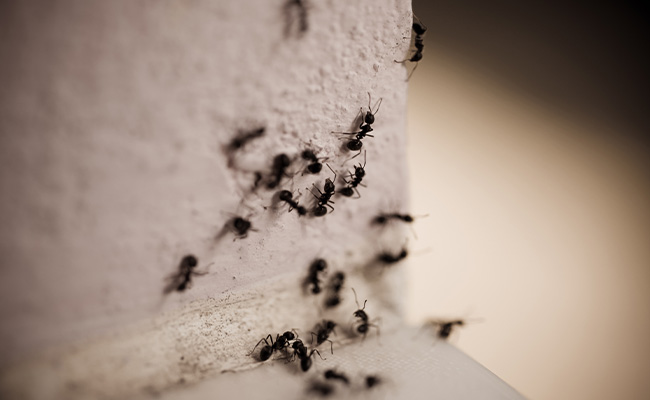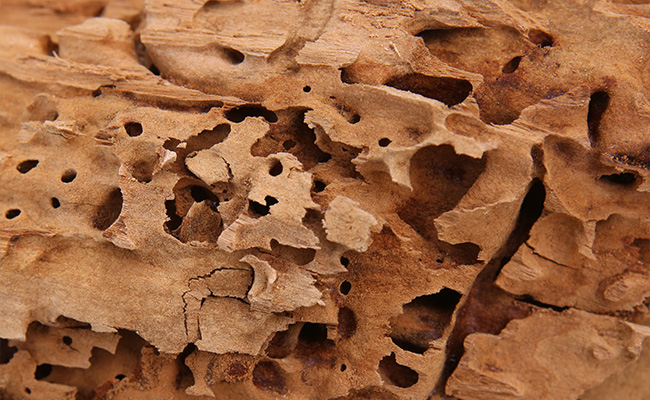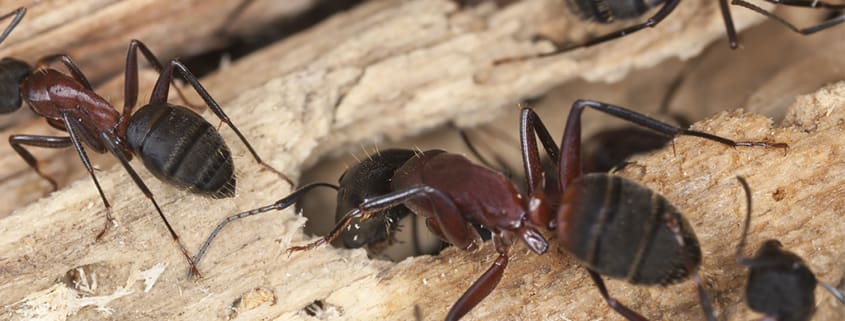How to Get Rid of Carpenter Ants in Your House
It may come as a shock that there are over 12,000 species of ants in the world (and we ant joking!). While most species are harmless, there are a few species that can be destructive, especially to your home. Carpenter ants are one of those species. Carpenter ants can cause major damage to the structural integrity of your home, by chewing the wood inside and outside of your home.
As a homeowner, it can save you a lot of stress and money if you can recognize the signs of a carpenter ant infestation and know how to get rid of them. Pest Pros is here to tell you everything you need to know about carpenter ants and the steps to take for ant control and extermination. Read on to discover how to get rid of carpenter ants in your house.
What is a Carpenter Ant?
Carpenter ants are named for their ability to build a nest by excavating wood and forming smooth tunnels inside of the wood. These nests are referred to as colonies and can contain up to 50,000 ants. Unlike other species of ants, carpenter ants will have a main colony and satellite colonies. Satellite colonies will primarily be established within a home and support the main colony located outside a home.


What do they look like?
Carpenter ants can be identified by their color, size, and shape. Carpenter ants are usually black, red, brown, red-brown, or red-black in color. Compared to other ants, carpenter ants are larger, about 3/4rd of an inch. They have six legs, an antennae, are segmented, and oval in shape.
How do they damage your home?
Carpenter ants are considered wood destroyers and are, compared, to termites. Unlike termites, carpenter ants do not eat wood and only chew wood to create a nest. Additionally, compared to termites, the amount of damage a carpenter ant can cause is far less; however, if the infestation of ants is not addressed over time, the damage can become severe as the nest grows.
What do they eat?
As mentioned, carpenter ants do not eat the wood they destroy. Carpenter ants eat other insects, such as aphids and other sugary insects.
Where do they live?

- Geographic region: Carpenter ants can primarily be found in areas with a large number of trees, such as Washington State. The rural and recently forested areas of Washington, such as Shelton, Gig Harbor, and Maple Valley, are prime areas for carpenter ants to live as they are heavily wooded and have a large amount of stumps to create nests.
- Area of home: Carpenter ants will target the large areas of sound woods in your home, such as beams, tresses, and joists. They will travel stealthily throughout your home by using wallboards.
- Do they bite? Carpenter ants do not bite humans. Thatching ants which are very similar in size and color to carpenter ants are the only ants to “bite” (technically, they sting) humans.
Signs of Carpenter Ants in Your Home
Recognizing the signs of carpenter ants in your home can be beneficial as a homeowner. It is also equally important to know why and how they get inside your home in the first place.
Carpenter ants will infiltrate your home when they’re looking for a new sound home to support their satellite colonies. They enter your house by either chewing their way through wood or climbing in through any crack. They will find their new home by using swarmers, which are reproducers, that fly and drop wings to find wood to create a colony (very few are successful in starting a colony). They will establish their satellite colonies in studs, walls, wood beams, and other areas of your home mentioned earlier. Primarily, carpenter ants prefer to target woods that are softened by water damage.
Unfortunately, finding signs you have carpenter ants can be difficult. One external sign of an infestation is small openings on the surface of the wood. Carpenter ants chew the wood and create galleys to live in, then spit out the debris, which appears as chunky thicker frass (fine wood shavings that are browner than dust). This thick frass is another external sign but can be hard to notice as it often looks like dust.
Since external signs are hard to identify, it can take a while to notice serious damage. The time it takes to notice external signs can also depend on the line carpenter ants create.
How to Get Rid of Carpenter Ants in Your House
As a homeowner, there are limited things you can do to help get rid of carpenter ants in your house if you notice the signs. Many homeowners opt for over-the-counter repellents to push the ants away; the issue with repellents, however, is that they will only kill ants if they come into direct contact with them, ultimately pushing the surviving untouched ants to an area that is more hidden and harder to reach. While repellents give off the illusion of a resolved issue, they will not push the satellite out entirely — and they also do not confront the original colony.
Over-the-counter repellents are not only ineffective at resolving the issue, but they also make the job more difficult for pest control professionals as they push the ants to harder-to-reach areas. For the sake of efficiency and effectiveness, we recommend contacting your local Pest Pros before attempting to resolve the issue yourself; this will ensure you have access to the best products and techniques for removing the entire colony.
To give you an idea of how a professional would get rid of carpenter ants in your house, we’ve outlined our typical process below:
Step 1: Inspection – Once the Pest Pros professional arrives on site, they will complete a full inspection of your home. They will tap wood beams to see if shavings fall out, check for small holes in other sound woods throughout your home, and check your crawl space to see where the ants are living.
Step 2: Treatment – After identifying the areas of your home the carpenter ants are present, the pest control professional will use a nicotine-based, commercial product to treat target areas, including:
- Treating around the foundation of your home. Ants are very social creatures, so, by treating the foundation of your home, the repellent will spread to every ant that the treated ant interacts with. After 2–3 weeks, professionals will return to the treated area to assess if there is any activity and if the treatment was successful.
- Drilling tiny holes in the wallboard, and inject repellent into holes.
- Treating the interior of your home with repellent during late fall (when carpenter ants go dormant). To ensure the safety of the homeowners, professionals like Pest Pros will use a nicotine-based product that human residents of the home cannot absorb.
Ideally, ants from the satellite colony within your home that are treated with a commercial product will return back to the main colony, carrying the treatment with them and spreading it throughout the main colony. In contrast, the majority of over-the-counter repellents take 48 hours to kill the first ant, which oftentimes is not enough time for ants within the satellite colony to build up food resources and bring back to the main colony.
Step 3: Maintenance – Our commercial products typically last for 6–8 weeks. Maintenance will be required to prevent the carpenter ants from returning. The maintenance program and intensity will depend on the season and the severity of the problem after an inspection of your home.
In addition to the outlined steps, we always recommend homeowners keep vegetation off their home as much as possible, trying not to stack wood around their homes (or up against the home), and avoiding buried railroad ties in the garden. All of these features of a home are perfect habitats for carpenter ants and can encourage them to take up residence in and around your home again.
Call Pest Pros for Carpenter Ant Removal
A broad understanding of the intricacies of colony dynamics and behavior make professional exterminators like those at Pest Pros the most qualified people for the job. The signs of a carpenter ant infestation are hard to identify and, you might not be able to identify the extent of the infestation or the current damage. Additionally, over-the-counter products will only produce a placebo effect — meaning the ants will be pushed away by the repellents, but won’t have died. Ultimately, in our somewhat-biased opinion, we recommend hiring a professional if you suspect a carpenter ant infestation in your home to ensure the problem is properly resolved.
Professionals like the team at Pest Pros will be able to complete a thorough inspection of your home, assess the damage, and create a course of action based on the most compromised, at-risk areas of your home. In addition, professionals are careful to avoid impacting off-target pests, like bees, ladybugs, or any pest that cannot survive in your home but are beneficial to the larger ecosystem.
While there is no shortage of exterminator companies you can call for carpenter ant removal, we humbly put our name in the hat. Pest Pros has built a reputation on genuinely caring about their customers and getting the job done right the first time. Get a free estimate from Pest Pros today!



 Free Image download from Pexels
Free Image download from Pexels